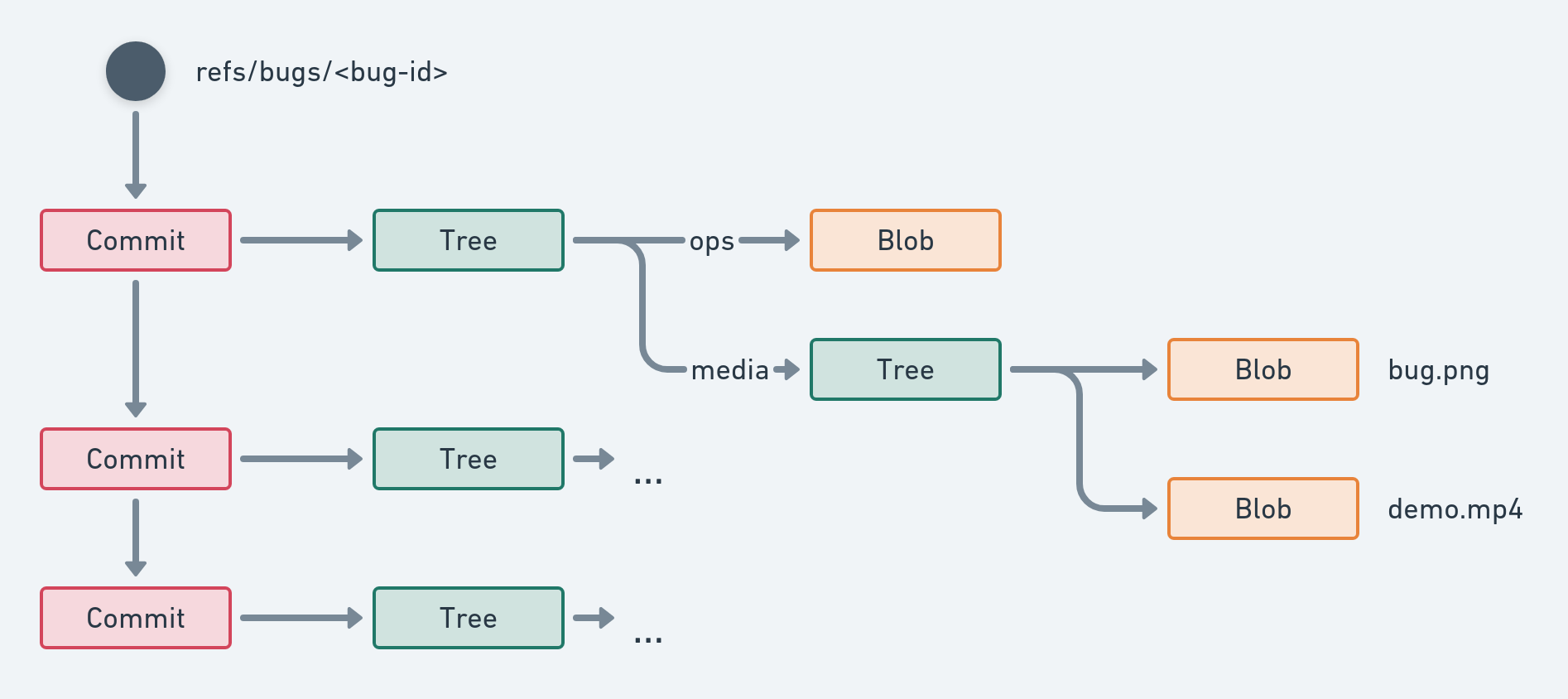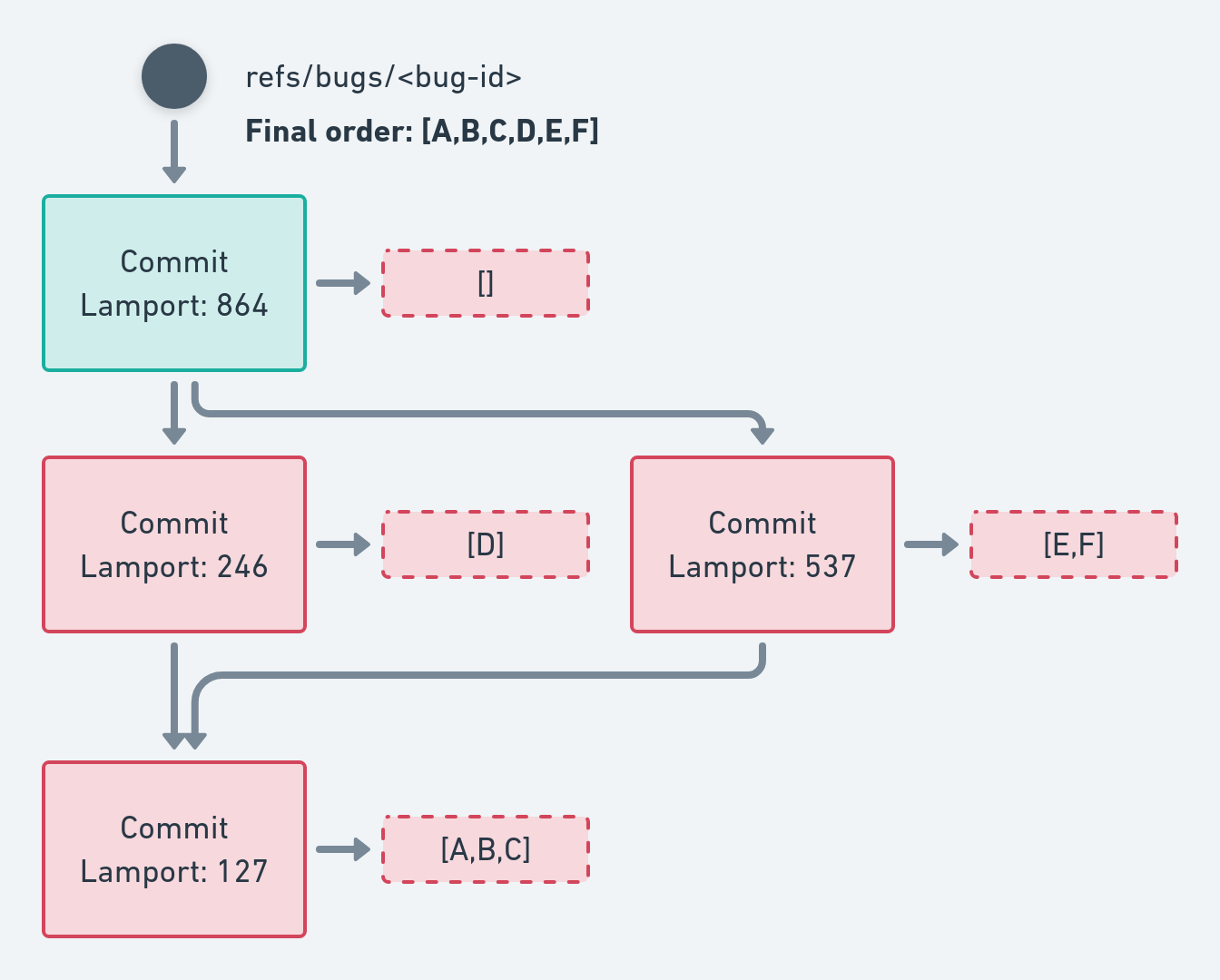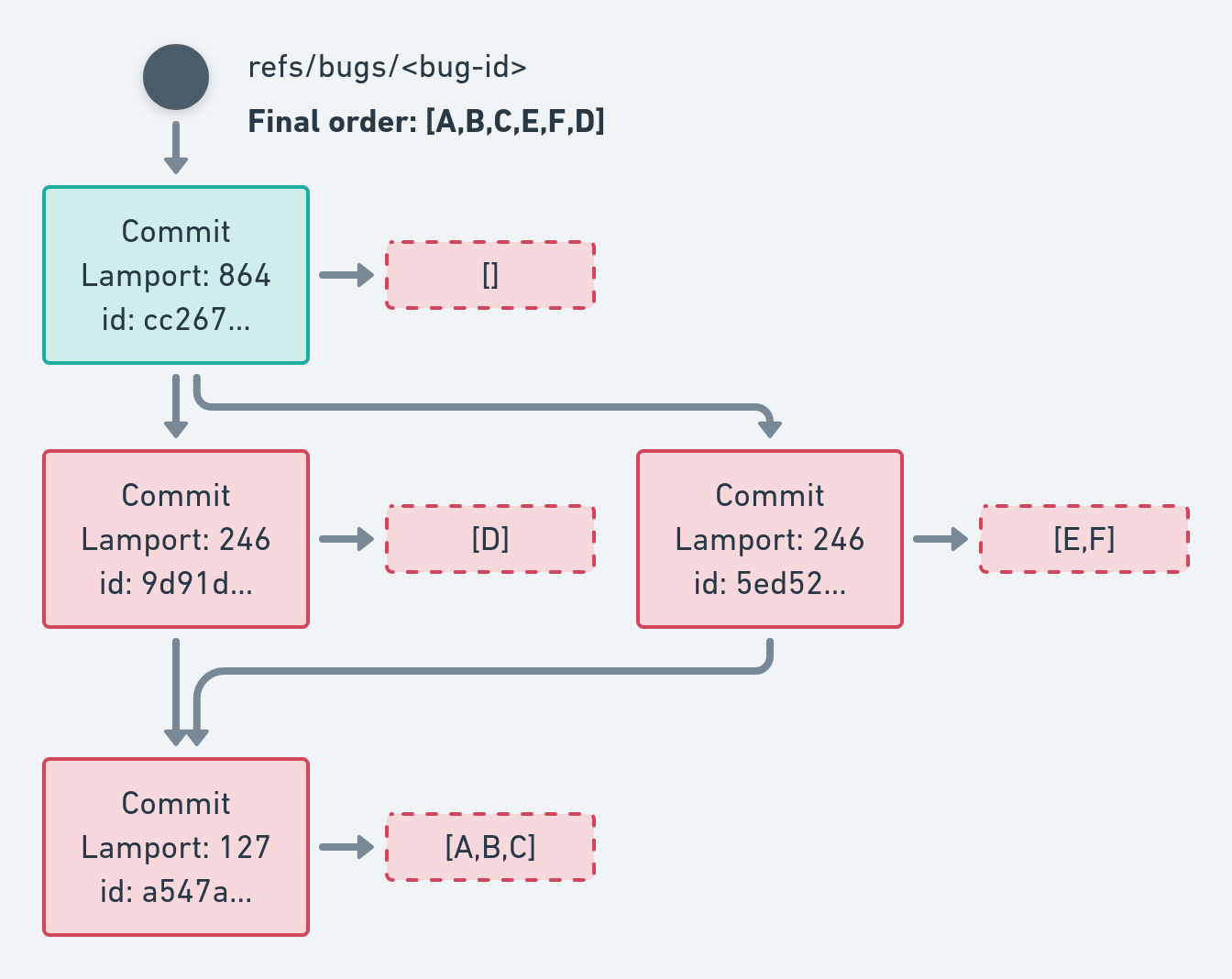git-bug's reusable entity data model
This document explains how git-bug's reusable distributed data structure in git is working. This data structure is capable of: - storing an entity (bug, pull-request, config...) and its complete history in git - carry signed authorship of editions - use git remotes as a medium for synchronisation and collaboration - merge conflicts - respect the rules you define as to what edition are possible - carry attached media
If you are looking for a different writing format or to see how you can easily make your own, checkout the example code.
If you are not familiar with git internals, you might first want to read about them, as the git-bug data model is built on top of them.
Entities (bug, author, ...) are a series of edit operations
As entities are stored and edited in multiple processes at the same time, it's not possible to store the current state like it would be done in a normal application. If two processes change the same entity and later try to merge the states, we wouldn't know which change takes precedence or how to merge those states.
To deal with this problem, you need a way to merge these changes in a meaningful way. Instead of storing the final bug data directly, we store a series of edit Operations. This is a common idea, notably with Operation-based CRDTs.

To get the final state of an entity, we apply these Operations in the correct order on an empty state, to compute (aka "compile") our view.
Entities are stored in git objects
An Operation is a piece of data, including:
- a type identifier
- an author (a reference to another entity)
- a timestamp (there is also one or two Lamport time)
- all the data required by that operation type (a message, a status ...)
- a random nonce to ensure we have enough entropy, as the operation identifier is a hash of that data (more on that later)
These Operations are aggregated in an OperationPack, a simple array. An OperationPack represents an edit session of the entity. As the operation's author is the same for all the OperationPack we only store it once.
We store this pack in git as a git Blob; that consists of a string containing a JSON array of operations. One such pack -- here with two operations -- might look like this:
{
"author": {
"id": "04bf6c1a69bb8e9679644874c85f82e337b40d92df9d8d4176f1c5e5c6627058"
},
"ops": [
{
"type": 3,
"timestamp": 1647377254,
"nonce": "SRQwUWTJCXAmQBIS+1ctKgOcbF0=",
"message": "Adding a comment",
"files": null
},
{
"type": 4,
"timestamp": 1647377257,
"nonce": "la/HaRPMvD77/cJSJOUzKWuJdY8=",
"status": 1
}
]
}
To reference our OperationPack, we create a git Tree; it references our OperationPack Blob under "/ops". If any edit operation includes a media (for instance in a text message), we can store that media as a Blob and reference it here under "/media".
To complete the picture, we create a git Commit that references our Tree. Each time we add more Operations to our bug, we add a new Commit with the same data-structure to form a chain of Commits.
This chain of Commits is made available as a git Reference under refs/<namespace>/<id>. We can later use this reference to push our data to a git remote. As git will push any data needed as well, everything will be pushed to the remote, including the media.
Here is the complete picture:

Time is unreliable
Before being able to merge conflicts, let's start with some building blocks.
It would be very tempting to use the Operation's timestamp to give us the order to compile the final state. However, you can't rely on the time provided by other people (their clock might be off) for anything other than just display. This is a fundamental limitation of distributed system, and even more so when actors might want to game the system.
Instead, we are going to use Lamport logical clock. A Lamport clock is a simple counter of events. This logical clock gives us a partial ordering:
- if L1 < L2, L1 happened before L2
- if L1 > L2, L1 happened after L2
- if L1 == L2, we can't tell which happened first: it's a concurrent edition
Each time we are appending something to the data (create an Entity, add an Operation) a logical time will be attached, with the highest time value we are aware of, plus one. This declares a causality in the events and allows ordering entities and operations.
The first commit of an Entity will have both a creation time and edit time clock, while a later commit will only have an edit time clock. These clocks value are serialized directly in the Tree entry name (for example: "create-clock-4"). As a Tree entry needs to reference something, we reference the git Blob with an empty content. As all of these entries will reference the same Blob, no network transfer is needed as long as you already have any entity in your repository.
Example of a Tree of the first commit of an entity:
100644 blob e69de29bb2d1d6434b8b29ae775ad8c2e48c5391 create-clock-14
100644 blob e69de29bb2d1d6434b8b29ae775ad8c2e48c5391 edit-clock-137
100644 blob a020a85baa788e12699a4d83dd735578f0d78c75 ops
Example of a Tree of a later commit of an entity:
100644 blob e69de29bb2d1d6434b8b29ae775ad8c2e48c5391 edit-clock-154
100644 blob 68383346c1a9503f28eec888efd300e9fc179ca0 ops
Entities and Operation's ID
Operations can be referenced - in the data model or by users - with an identifier. This identifier is computed from the Operation's data itself, with a hash of that data: id = hash(json(op))
For entities, git-bug uses as identifier the hash of the first Operation of the entity, as serialized on disk.
The same way as git does, this hash is displayed truncated to a 7 characters string to a human user. Note that when specifying a bug id in a command, you can enter as few characters as you want, as long as there is no ambiguity. If multiple entities match your prefix, git-bug will complain and display the potential matches.
Entities support conflict resolution
Now that we have all that, we can finally merge our entities without conflict, and collaborate with other users. Let's start by getting rid of two simple scenarios:
- if we simply pull updates, we move forward our local reference. We get an update of our graph that we read as usual.
- if we push fast-forward updates, we move forward the remote reference and other users can update their reference as well.
The tricky part happens when we have concurrent editions. If we pull updates while we have local changes (non-straightforward in git term), git-bug creates the equivalent of a merge commit to merge both branches into a DAG. This DAG has a single root containing the first operation, but can have branches that get merged back into a single head pointed by the reference.
As we don't have a purely linear series of commits/Operationss, we need a deterministic ordering to always apply operations in the same order.
git-bug applies the following algorithm:
- load and read all the commits and the associated
OperationPacks - make sure that the Lamport clocks respect the DAG structure: a parent commit/
OperationPack(that is, towards the head) cannot have a clock that is higher or equal than its direct child. If such a problem happens, the commit is refused/discarded. - individual
Operations are assembled together and ordered given the following priorities: - the edition's lamport clock if not concurrent
- the lexicographic order of the
OperationPack's identifier
Step 2 is providing and enforcing a constraint over the Operation's logical clocks. What that means, is that we inherit the implicit ordering given by the DAG. Later, logical clocks refine that ordering. This - coupled with signed commits - has the nice property of limiting how this data model can be abused.
Here is an example of such an ordering:

We can see that:
- Lamport clocks respect the DAG structure
- the final
Operationorder is [A,B,C,D,E,F], according to those clocks
When we have concurrent editions, we apply a secondary ordering, based on the OperationPack's identifier:

This secondary ordering doesn't carry much meaning, but it's unbiased and hard to abuse.
